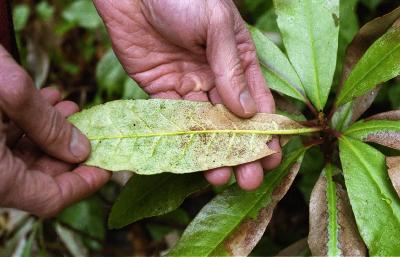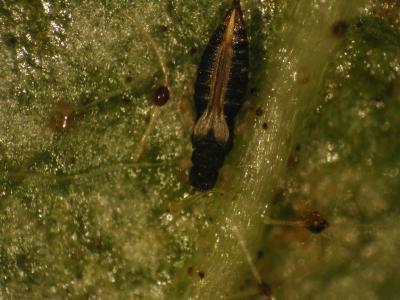March 4, 2004
Gardeners do battle with tiny foe
UW gardeners are fighting a war against an enemy that is tiny in size but devastating in impact. An insect commonly called greenhouse thrips has expanded its usual campus diet from a couple of common shrubs to a list of at least 17 different plants, leaving unsightly gray-brown leaves in its wake.
|
| The tiny insect thrips, as viewed through a microscope. |
“We see this as an epidemic,” says Grounds Manager Rod White. “There’s not just one part of campus that’s affected; there’s not just one plant that’s affected. It’s throughout campus and on many plants.”
If you took your pencil and made a dot on a piece of paper, the dot would be only slightly smaller than the typical thrips, which viewed through a microscope, looks a little like a termite. But the tiny critters have big appetites. As they feed on the underside of a leaf, their mouth cuts into the cells and sucks the juices out. When they’ve finished with a plant, the leaves not only lose their green color, but also are covered with brown spots — the waste products from the thrips.
Thrips are always around and are a particular problem in greenhouses, White says, but this year they were more plentiful than usual, which caused them to venture from their favorite hosts, the evergreen shrubs viburnum and salal, to a whole list of other plants, including rhododendrons, azaleas, boxwood and more.
Gardeners first began reporting the problem last summer, and by fall, the grounds crew knew they had an epidemic on their hands. That’s when White decided extra help was needed. Enter Michael Andreu, a graduate student in Forest Resources and the “integrated pest management coordinator,” whose job is to assist the gardeners with pest problems like this one. He and White, along with Campus Landscape Architect Bill Talley, began drawing up plans for the thrips war.
“We’re in the intelligence gathering phase right now,” White says.
Gardeners have been asked to identify beds of plants in their area that have a thrips infestation. Each bed will get a number. Then the gardeners will identify each infested plant in the bed. Once the inventory is complete, a treatment plan will be devised.
And this won’t be a simple “hit them all with a pesticide” plan, either. Instead, a number of different treatments will be tried, turning the effort into a practical experiment. “We’ve had a series of meetings with the gardeners and they’re very enthusiastic about this,” Andreu says.
Some of the treatments being considered include knocking the thrips off the leaves with a high pressure hose, introducing a tiny Australian wasp whose eggs become a parasite on the thrips, applying a fungus that will digest the thrips without harming the leaves and using a systemic pesticide that turns the plant into a poison for the thrips.
Different treatments will likely be applied in different areas and the results compared. It’s also possible that in some areas, plants infested with thrips will simply be removed or not replanted if they die from thrips.
“If some plants, like the viburnum, for example, are such good hosts for the thrips that they’re a problem, we may not want to have those plants around,” Andreu says.
Andreu and White hope the experiment will not only solve the immediate thrips problem but result in greater knowledge about the insect that can be used to prevent or at least minimize future outbreaks.
“There’s been a lot of research about thrips in the greenhouse setting but not much in the landscape setting in the Pacific Northwest,” Andreu says. “We’d like to know if our problem is weather-related — did the thrips become plentiful because last winter was especially mild?”
Because such knowledge can’t be obtained in a short time, Andreu and White expect that the campus experiment will be ongoing
“To my knowledge this is the first time the gardeners have participated in an experiment like this,” White says. “It’s been exciting for them — to have the whole shop involved in meetings and keeping abreast of the information as it comes in. And there have been a lot of players contributing. In addition to Michael and Bill Talley, my boss Jon Hooper is involved, and we’ve called in Greenhouse Manager Doug Ewing because of his experience with thrips and Bob Gara, the entomologist in forestry. That team approach has made it a very rewarding experience.”





